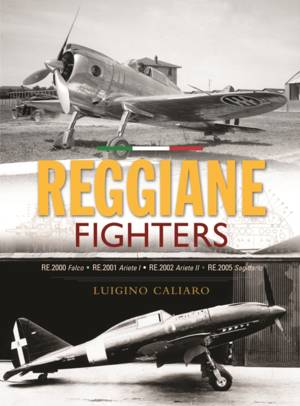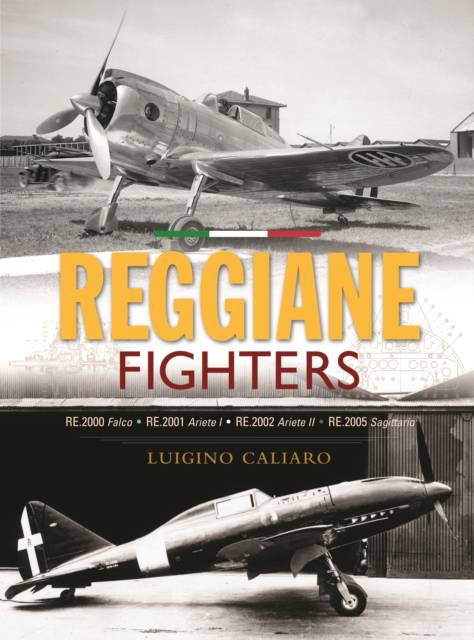
- Afhalen na 1 uur in een winkel met voorraad
- Gratis thuislevering in België vanaf € 30
- Ruim aanbod met 7 miljoen producten
- Afhalen na 1 uur in een winkel met voorraad
- Gratis thuislevering in België vanaf € 30
- Ruim aanbod met 7 miljoen producten
Zoeken
Omschrijving
In this final volume in his trilogy on the main Italian fighter types to see service in the Second World War, aviation historian Luigino Caliaro tells the story of Reggiane's aircraft.
During the mid-1930s, influenced by aircraft designs from the USA, Reggiane commenced work on the all-metal, radial engined RE.2000 Falco which first flew in May 1939. An adaptation of the RE.2000 intended to accommodate the German liquid-cooled Daimler-Benz 601A engine resulted in the RE.2001 Ariete I of which more than 230 were delivered to the Regia Aeronautica. It was deployed for escorting Italian and Luftwaffe bombers in attacks on Malta in 1942, as well as mounting free-range fighter sweeps. The RE.2002 Ariete II was a fighter-bomber/ground-attack aircraft powered by a 14-cylinder Piaggio radial engine which saw service with the Regia Aeronautica against Allied shipping and troops, particularly during the Allied invasion of Sicily.
Coverage is also given to the thinking behind the RE.2003 and well as the RE.2005 Sagittario which was one of the last fighters to enter Regia Aeronautica service and which, like the RE.2002, was used in limited numbers by the Luftwaffe.
Drawing on company documents and military archives, the book details the design and development of each type, as well as production, prototypes and technical aspects and also covers camouflage and markings, as well as descriptions of Reggiane fighters that have survived to this day.
With hundreds of rare and fascinating photographs, items of ephemera, colour artwork and technical drawings, this book reflects the exemplary analysis and detail of the author's acclaimed earlier studies of Macchi and FIAT fighters.
During the mid-1930s, influenced by aircraft designs from the USA, Reggiane commenced work on the all-metal, radial engined RE.2000 Falco which first flew in May 1939. An adaptation of the RE.2000 intended to accommodate the German liquid-cooled Daimler-Benz 601A engine resulted in the RE.2001 Ariete I of which more than 230 were delivered to the Regia Aeronautica. It was deployed for escorting Italian and Luftwaffe bombers in attacks on Malta in 1942, as well as mounting free-range fighter sweeps. The RE.2002 Ariete II was a fighter-bomber/ground-attack aircraft powered by a 14-cylinder Piaggio radial engine which saw service with the Regia Aeronautica against Allied shipping and troops, particularly during the Allied invasion of Sicily.
Coverage is also given to the thinking behind the RE.2003 and well as the RE.2005 Sagittario which was one of the last fighters to enter Regia Aeronautica service and which, like the RE.2002, was used in limited numbers by the Luftwaffe.
Drawing on company documents and military archives, the book details the design and development of each type, as well as production, prototypes and technical aspects and also covers camouflage and markings, as well as descriptions of Reggiane fighters that have survived to this day.
With hundreds of rare and fascinating photographs, items of ephemera, colour artwork and technical drawings, this book reflects the exemplary analysis and detail of the author's acclaimed earlier studies of Macchi and FIAT fighters.
Specificaties
Betrokkenen
- Auteur(s):
- Uitgeverij:
Inhoud
- Aantal bladzijden:
- 272
- Taal:
- Engels
Eigenschappen
- Productcode (EAN):
- 9781800353527
- Verschijningsdatum:
- 8/01/2026
- Uitvoering:
- Hardcover
- Formaat:
- Genaaid
- Afmetingen:
- 229 mm x 305 mm
- Gewicht:
- 1584 g

Alleen bij Standaard Boekhandel
+ 111 punten op je klantenkaart van Standaard Boekhandel
Beoordelingen
We publiceren alleen reviews die voldoen aan de voorwaarden voor reviews. Bekijk onze voorwaarden voor reviews.








